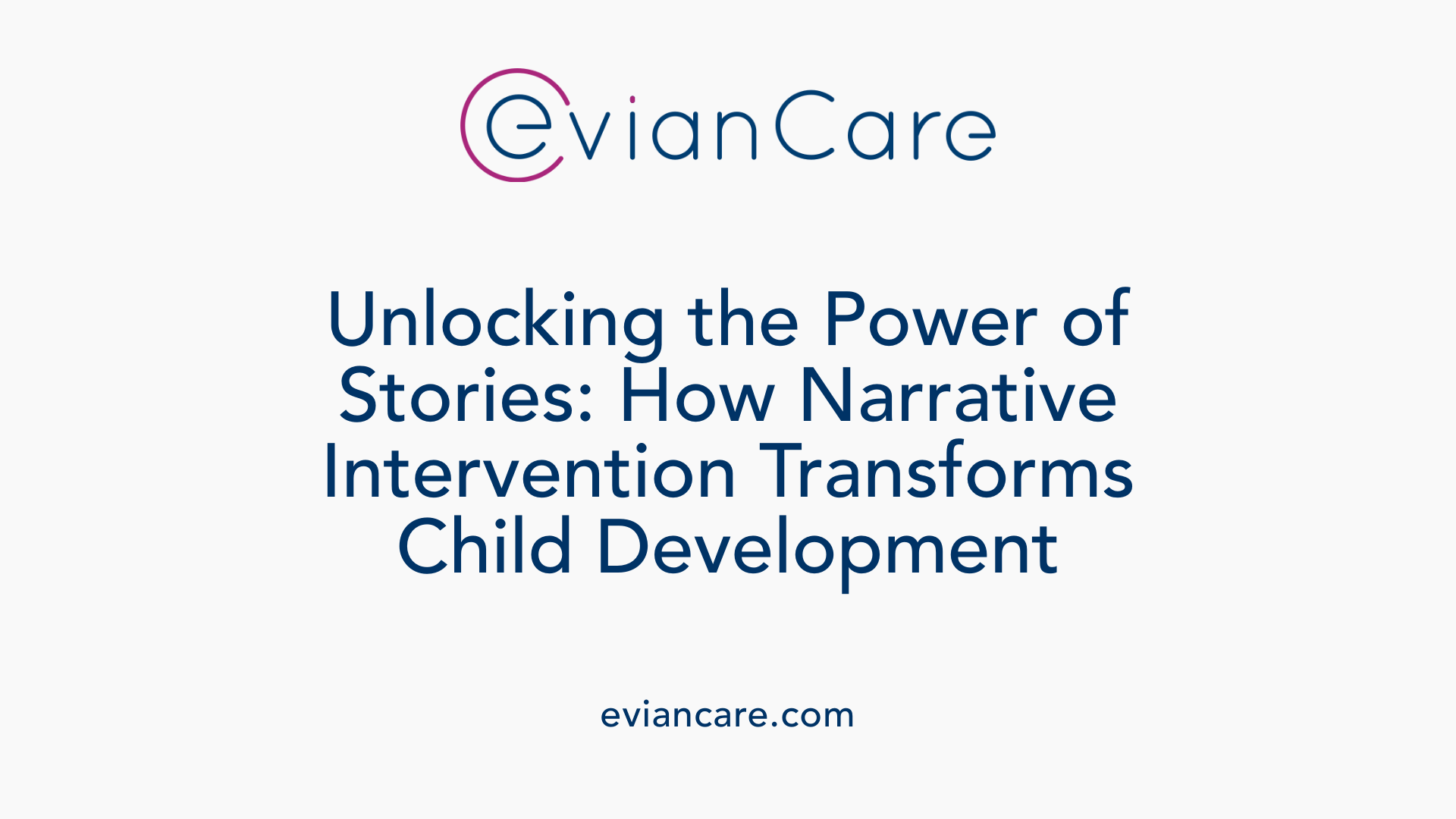
Unlocking the Power of Storytelling in Speech Therapy
Narrative skills are a cornerstone of effective communication and academic success. Speech therapy focused on developing these skills equips children to tell stories, retell experiences, and understand story structures, fostering social, emotional, and educational growth. This article explores the strategies, goals, and principles behind successful narrative interventions in speech-language pathology.
Understanding the Role of Narrative Skills in Child Development
How do narrative skills develop from age 2 through adolescence?
Narrative development is a gradual process that begins early in childhood and continues into adolescence. Starting at around age 2, children typically begin retelling familiar routines and simple personal experiences. As they grow, their stories become more detailed, including elements like characters, setting, and a sequence of events.
By age 5 to 7, children usually can retell familiar stories, understand story structure, and include basic story components such as problem and solution. During elementary school years, their narratives become more complex with an increased use of descriptive language, inference, and varied vocabulary. Adolescents refine their storytelling skills further by creating more elaborate and cohesive fictional and personal stories, demonstrating advanced use of grammar, inference, and social pragmatics.
This developmental trajectory supports children’s ability to understand and produce organized narratives, which are foundational for academic and social success.
How are narrative skills related to vocabulary, listening, reading comprehension, and writing?
Narrative abilities are closely linked to several essential language skills. Strong storytelling skills correlate with a broader vocabulary, as children learn new words through story context and storytelling activities.
Listening skills also improve when children understand story structure and infer meaning from narratives. These skills, in turn, support reading comprehension, especially in understanding story elements, main ideas, and the macrostructure of texts.
Developing narratives enhances writing by helping children organize ideas, use cohesive devices, and expand vocabulary. Together, these skills create a foundation for academic achievement, as children who master storytelling tend to perform better in reading comprehension, spelling, and writing tasks.
| Skill Area | Relationship to Narratives | Impact on Learning |
|---|---|---|
| Vocabulary | Stories introduce new words through context | Broader language use and understanding |
| Listening | Following story sequences and inferencing | Enhanced listening comprehension |
| Reading Comprehension | Understanding story structure and elements | Improved ability to interpret texts |
| Writing | Organizing ideas and using language cohesively | Better written expression |
Recognizing these connections underscores why developing robust narrative skills is a priority in speech and language intervention.
What are typical narrative skills goals in speech therapy?
Goals in speech therapy often focus on developing children’s understanding and use of story components such as characters, setting, problem, and resolution. Therapists aim to enhance sequencing skills and coherence in storytelling.
Other objectives include expanding vocabulary, using conjunctions to connect ideas, and employing descriptive language. These goals support not only communication competence but also academic success, especially in reading comprehension and writing.
What is the narrative approach in speech therapy?
The narrative approach emphasizes guiding children to produce coherent and meaningful stories. It involves teaching story elements like characters, setting, and sequence, while fostering retelling and comprehension.
This approach helps children improve both expressive language (telling stories) and receptive language (understanding stories). It encourages active participation through storytelling, retelling familiar episodes, and creating personal or fictional narratives.
How can speech therapy develop children's storytelling and retelling abilities?
Speech therapy enhances storytelling by focusing on teaching story elements, sequencing, and extracting the main idea. Therapists use visual supports such as story grammar cards, graphic organizers, and picture cues to aid understanding.
Encouraging children to make personal connections within stories and infer meanings also boosts coherence and confidence. Activities often involve retelling stories, creating new narratives, and practicing story structure, which together foster expressive and receptive skills.
What are effective principles of narrative intervention in speech therapy?
Effective interventions teach story structure systematically, ensuring children understand the order and relationship of story components. Using visual supports like graphic organizers helps children visualize and organize their stories.
Interventions should promote active participation and be tailored to individual needs. Incorporating fun, engaging activities helps motivate children, making learning enjoyable. Strategies include story retelling, story creation, and scaffolding to support gradual independence.
By combining these principles, therapy can effectively improve children’s ability to tell and understand stories, which in turn supports broader language and social skills.
Core Components and Benefits of Narrative Interventions

What are typical narrative skills goals in speech therapy?
Goals in narrative interventions often focus on helping children understand and use story components such as characters, setting, problems, attempts at solutions, and outcomes. Therapists aim to improve sequencing—so children can tell stories in logical order—and coherence to ensure stories make sense. Additionally, developing expressive language involves expanding vocabulary, using descriptive language, and incorporating appropriate syntax and grammar.
What is the narrative approach in speech therapy?
The narrative approach centers on teaching children how to construct and interpret stories. This method emphasizes understanding story structure, including key elements like beginning, middle, and end, as well as coherence between story parts. Importantly, it also addresses social-pragmatic skills, helping children communicate effectively and relate to others through storytelling.
How can speech therapy develop children's storytelling and retelling abilities?
Effective strategies include targeted practice on story elements such as characters, settings, and plot. Using visual supports like graphic organizers and story cards promotes understanding and recall. Activities such as story retelling, creating personal stories, and playing pretend help children organize their thoughts and expand their expressive skills. Multimodal approaches—incorporating verbal, visual, and tactile methods—enhance learning and engagement.
What are effective principles of narrative intervention in speech therapy?
Successful interventions employ visual supports, such as story grammar charts and picture cues, to scaffold learning. Fun and age-appropriate activities maintain motivation and interest. Scaffolding progressively supports children's independence, gradually reducing prompts as they become more confident storytellers. Incorporating multiple exemplars helps children generalize skills across different stories and improve metalinguistic understanding.
How do narrative components contribute to language development?
Story grammar elements provide a structural framework that supports the development of syntax, vocabulary, and pragmatic language skills. Teaching these elements helps children retell stories, understand written texts, and develop the ability to infer meaning and organize information efficiently. These skills are crucial for academic success, particularly in reading comprehension, and also enhance social interaction by enabling children to share experiences effectively.
Practical tools and assessment
Effective therapy integrates visual aids like graphic organizers and story charts and may involve assessment tools such as the Test of Narrative Language or Edmonton Narrative Norms Instrument. These assessments help track progress and inform goal-setting.
| Component | Description | Purpose |
|---|---|---|
| Story Grammar Elements | Characters, setting, problem, attempts, resolution, outcomes | Structure stories for clarity and coherence |
| Visual Supports | Picture cards, graphic organizers | Facilitate understanding and recall |
| Activities | Retelling, story creation, drawing, role-play | Practice storytelling and expressive skills |
Overall, narrative-based interventions are versatile, engaging, and effective in fostering language and social skills. When implemented with variety and fun, they support children's academic progress and social relationships, making storytelling a powerful tool in speech therapy.
Techniques and Strategies for Narrative Skill Development
How can speech therapy develop children's storytelling and retelling abilities?
Developing strong storytelling and retelling skills is essential for children’s language and social development. Effective speech therapy employs a variety of engaging, multimodal activities to make learning both fun and meaningful. For example, using story prompts that encourage children to recall personal experiences or imagine fictional scenarios helps them practice organizing their thoughts.
Visual supports like graphic organizers, story grammar cards, and picture cues serve as concrete tools that guide children through the story structure process. These aids help children understand essential story elements such as characters, settings, problems, and solutions, which are vital for both comprehension and retelling.
Incorporating pretend play, drawing, and creating stories based on past or imaginary events further enriches skill development. These activities motivate children, helping them internalize story elements while fostering creativity and expressive language use.
Frequent modeling by therapists, where they demonstrate storytelling and elaboration techniques, supports children in understanding how to extend their narratives. Repeated practice, combined with elaboration and scaffolding, encourages generalization of skills across different contexts. This approach also promotes metalinguistic awareness, such as understanding story structure and the use of cohesive devices.
What are effective principles of narrative intervention in speech therapy?
Employing visual supports, active participation, differentiation, and fun activities to foster narrative skill growth are fundamental principles. Using visual aids like graphic organizers helps children visualize story elements, boosting both comprehension and production.
Active participation ensures children are engaged and motivated, which enhances learning outcomes. Differentiation tailored to each child’s developmental level allows targeted support for individual needs.
Making therapy sessions enjoyable through game-like activities and themed story discussions also keeps children motivated and eager to participate.
How can speech therapy use techniques and tools for optimal results?
By integrating multimodal approaches that combine verbal instruction, visual aids, and tactile elements, children can better understand and retain story structures. Repeated modeling, where the therapist demonstrates storytelling techniques multiple times, helps children grasp complex concepts.
Additionally, scaffolding strategies—gradually reducing assistance as children become more proficient—are crucial for fostering independence in storytelling. Regular use of thematic story grammar resources aligned with children’s interests and seasons can maintain engagement.
Overall, when these strategies are implemented consistently, they promote the development of cohesive, detailed narratives that transfer well across academic and social environments.
Assessment and Measurement of Narrative Skills
 Evaluating children’s narrative skills is essential to understanding their language development and planning effective interventions. Several formal assessment tools are commonly used in speech therapy to measure narrative abilities. These include the Test of Narrative Language (TNL), the Edmonton Narrative Norms Instrument, and the CUBED narrative language assessment. These tools help clinicians determine areas of strength and weakness in storytelling, retelling, and understanding story structure.
Evaluating children’s narrative skills is essential to understanding their language development and planning effective interventions. Several formal assessment tools are commonly used in speech therapy to measure narrative abilities. These include the Test of Narrative Language (TNL), the Edmonton Narrative Norms Instrument, and the CUBED narrative language assessment. These tools help clinicians determine areas of strength and weakness in storytelling, retelling, and understanding story structure.
Goals in speech therapy are typically derived from assessment data. They often focus on enhancing the child's ability to organize and tell stories with clear story elements such as characters, settings, problems, and solutions. Objectives may also target vocabulary use, syntactic complexity, coherent sequencing, and the ability to retell stories accurately. For example, a goal might be for a child to include at least three story grammar elements when retelling a story or to improve the richness of vocabulary during storytelling.
The narrative approach in speech therapy combines systematic evaluation with targeted activities designed to improve storytelling and retelling skills. Speech-language pathologists use a variety of assessment methods, including language samples and rubrics, to monitor progress over time. Activities such as story retelling, personal narrative creation, and the use of visual supports allow children to practice and enhance their narrative abilities.
Developing children’s storytelling and retelling skills involves continuous assessment, providing immediate feedback, and adjusting therapy goals as needed. Incorporating both formal assessments like standardized tests and informal observations helps therapists gain a comprehensive picture of a child's abilities. Regular use of visual aids, prompts, and multimodal supports can further facilitate improvement.
Effective principles of narrative intervention include basing goals on thorough data analysis, employing diverse assessment techniques, and using rubrics that evaluate multiple aspects of narrative production. This data-driven approach enables therapists to tailor interventions specifically to each child's needs, track progress accurately, and ensure meaningful skill development.
Overall, systematic assessment combined with targeted, feedback-informed therapy facilitates the growth of children’s narrative skills, which are vital for academic success and social interactions.
Applying Principles for Effective Narrative Interventions

What are effective principles of narrative intervention in speech therapy?
Successful narrative interventions in speech therapy focus on engaging children in meaningful storytelling activities. Interventions should be fun, motivating, and tailored to each child's developmental level and interests. Essential elements include scaffolding, which provides appropriate support while gradually reducing assistance, and specific prompts that guide story development and retelling.
Promoting generalization across different settings and contexts is crucial. This means children can apply their storytelling skills in everyday situations, such as classroom conversations or social interactions. Using visual supports like graphic organizers, story grammar cards, and picture cues helps children understand and organize their stories, making learning more effective.
How can speech therapy develop children's storytelling and retelling abilities?
Embedding storytelling activities within everyday routines, play, and social interactions makes learning natural and engaging. For example, singing nursery rhymes, drawing pictures, and encouraging children to 'read' or tell stories based on pictures promote language development.
Supporting children with visual aids and offering opportunities for them to participate actively—through retelling personal experiences or creating fictional stories—enhances their narrative skills. Visual supports like story maps or story grammar cues help children understand story structure.
Group and individual therapy sessions also foster social interaction, which is vital for pragmatic language development. These contexts provide children with practice in listening, turn-taking, and giving feedback, all of which support storytelling proficiency.
What is the narrative approach in speech therapy?
The narrative approach emphasizes active participation, meaning children are encouraged to tell their stories and engage with story elements throughout therapy sessions. It involves adapting activities to meet each child's unique needs and interests.
Therapists use contextualized story learning, associating stories with familiar routines or themes, to make the experience relevant. This personalized, interactive method helps children develop both expressive and receptive language skills.
Research supports that such approaches improve understanding of story structure, enhance vocabulary, and boost social pragmatics. By encouraging children to create and retell stories, therapists help them build essential language and communication skills that carry over into classroom and social settings.
Enhancing Narrative Skills Through Fun and Engagement

Involving children in singing nursery rhymes, reading, pretend play, writing stories.
To develop narrative skills effectively, children should be engaged through activities that are both enjoyable and meaningful. Singing nursery rhymes introduces rhythm and repetitive language patterns that aid in memory and language development. Reading books with vivid pictures encourages children to understand story structure and vocabulary.
Pretend play allows children to create and act out stories, fostering their ability to organize events and imagine different perspectives. Writing stories about personal experiences or imaginary scenarios helps them practice storytelling, sequencing, and vocabulary use. These activities not only make learning fun but also provide ample opportunities for repeated practice, which is essential for mastery.
What are effective principles of narrative intervention in speech therapy?
Research highlights that effective narrative therapy is grounded in activities that are fun, engaging, and relevant to children's interests. Making sessions enjoyable maintains motivation and encourages children to participate actively. Using visual supports like picture cards and graphic organizers helps children understand story elements while keeping the process interactive.
Incorporating game-like activities, immediate positive feedback, and playful prompts creates a supportive learning environment. This approach ensures children are not overwhelmed and can develop complex language skills gradually.
How can speech therapy develop children's storytelling and retelling abilities?
Storytelling and retelling can be enhanced through a variety of playful and relatable activities. Story retelling exercises, supported by visual aids such as story grammar cards, help children learn to include important story components like characters, setting, problem, and resolution.
Creating stories together, using wordless picture books, or drawing pictures then describing them encourages children to organize their thoughts and extend their narrative skills. Repetition of story-related activities, coupled with scaffolding and graduated support, allows children to gain confidence and improve their ability to recall and retell stories accurately.
What is the narrative approach in speech therapy?
The narrative approach centers on the child's active participation and creativity. It emphasizes understanding story structure and elements through interactive methods such as storytelling games, personal narratives, and guided story creation.
This approach combines visual supports, such as story maps, with verbal prompts to reinforce learning of story components. The child's interests and cultural context are considered, making the intervention personalized and relevant. By fostering a fun, engaging environment, the narrative approach not only improves language skills but also enhances social-pragmatic abilities, essential for peer interactions.
| Activity Type | Focus Area | Benefits | Examples |
|---|---|---|---|
| Singing nursery rhymes | Rhythm, vocabulary | Builds phonological awareness | Singing popular nursery songs |
| Book reading | Vocabulary, story structure | Improves comprehension | Reading picture books with discussion |
| Pretend play | Imaginative narrative | Enhances creativity and organization | Playing 'store' or 'family' scenarios |
| Writing stories | Sequencing, vocabulary | Strengthens expressive language | Creating stories about holidays or imaginary creatures |
| Visual aids and graphic organizers | Story components | Supports understanding of story constituents | Using story maps and picture cues |
In sum, integrating enjoyable activities into speech therapy sessions not only promotes children's motivation but also accelerates their development of essential narrative skills. These methods encourage children to tell, retell, and create stories that serve vital academic and social functions, laying a foundation for future success.
Conclusion: The Impact of Narrative Intervention on Child Outcomes
 Supporting children's development through narrative interventions has profound effects on their language, social, academic, and emotional skills. When children learn to tell and retell stories with structured elements like characters, settings, problems, and solutions, they build a foundation for understanding complex language and concepts. These skills are not only beneficial for immediate communication but also serve as predictors of future academic success, especially in reading comprehension.
Supporting children's development through narrative interventions has profound effects on their language, social, academic, and emotional skills. When children learn to tell and retell stories with structured elements like characters, settings, problems, and solutions, they build a foundation for understanding complex language and concepts. These skills are not only beneficial for immediate communication but also serve as predictors of future academic success, especially in reading comprehension.
In speech therapy, typical goals focus on supporting children's ability to understand story structure and expressively produce stories that include key components such as characters, actions, and outcomes. This comprehensive approach ensures children grasp the main ideas and details, improving both receptive and expressive language abilities. Therapy strategies involve structured activities like story retelling, story creation, and use of visual aids such as graphic organizers and story grammar cards.
Effective principles of narrative intervention emphasize systematic teaching, engaging multimodal methods, visual supports, and opportunities for generalization. Therapy should be fun and motivating, incorporating activities like singing nursery rhymes, drawing, pretend play, and story-enrichment exercises aligned with children's interests. Differentiation and scaffolding are essential to meet individual learning needs and promote sustained improvements.
These interventions have lasting impacts. As children enhance their story comprehension, vocabulary, syntax, and pragmatic skills, they tend to become more socially accepted, build stronger relationships with peers, and participate more actively in classroom settings. The development of narrative skills from early childhood through adolescence influences literacy skills, future academic achievement, and social-emotional growth.
Research supports that working on oral and written narrative abilities can lead to significant gains in understanding story elements, making inferences, and organizing information. By investing in targeted, engaging, and systematically guided narrative interventions, caregivers and clinicians can foster lifelong skills that extend well beyond language: they empower children to connect, collaborate, and succeed within their communities.
Fostering Lifelong Literacy and Social Skills with Narrative Practice
Effective narrative intervention in speech therapy is pivotal for enhancing children's language, literacy, and social connections. By employing research-based strategies—structured storytelling, visual supports, engaging activities, and systematic assessment—therapists can help children develop the skills necessary for successful communication and academic achievement. The investment in narrative skill development lays a foundation for lifelong learning and social engagement, making it a vital component of comprehensive speech-language therapy.
References
- Narrative Intervention: Principles to Practice - ASHA Journals
- Tips for Helping Your Child Develop Narrative Language Skills
- Short Stories for Narrative Intervention - Speechy Musings
- Narrative Language Goals for Speech Therapy - SLP Now
- Story Grammar Activities to Improve Narrative Skills in Speech
- Oral Narratives In Speech Therapy - The Gift of Gab
- Jessica, Author at The Gift of Gab - Page 6 of 6












